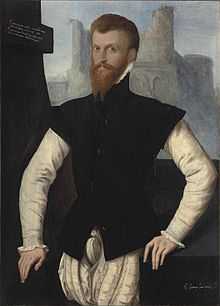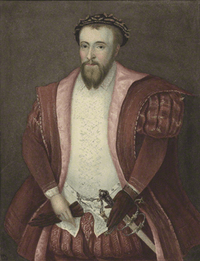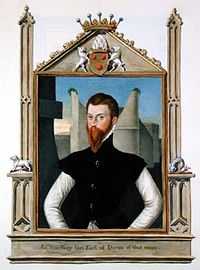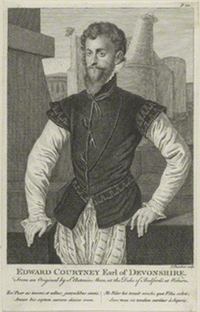Edward Courtenay, 1st Earl of Devon
| Edward Courtenay | |
|---|---|
 Edward Courtney, Earl of Devon, unknown artist, English School, c. 1555 | |
| Born | 1526 |
| Died |
9 September 1556 (aged 29) Padua, Republic of Venice |
| Title | Earl of Devon |
| Spouse(s) | Laurana de' Medici (Rumored) |
| Parent(s) |
Henry Courtenay, 1st Marquess of Exeter Gertrude Blount |



Edward Courtenay, 1st Earl of Devon (c. 1527 – 18 September 1556) was an English nobleman during the rule of the Tudor dynasty. Born into a family with close royal connections, he was at various times considered a possible match for the two daughters of his first cousin once removed, Henry VIII, both of whom became queens regnant of England.
Life
Edward was the only son of Henry Courtenay, 1st Marquess of Exeter and his second wife, Gertrude, daughter of William Blount, 4th Baron Mountjoy. Edward's paternal grandmother, Catherine of York, was a daughter of Edward IV of England and a sister of Elizabeth of York, Queen of England. Edward was thus a first cousin once removed of King Henry VIII of England and Queen Margaret of Scotland, and a second cousin to (among others) James V of Scotland, Margaret Douglas, Mary I of England, Elizabeth I of England, Edward VI of England, Henry Brandon, 1st Earl of Lincoln, Lady Frances Brandon and Lady Eleanor Brandon.
The first decade of Edward's life was relatively peaceful. His father was a prominent figure in the court and his mother enjoyed the friendship of Catherine of Aragon even after her removal from court and throne.
Imprisonment
In early November, 1538, all three Courtenays were arrested and incarcerated in the Tower of London. His father was accused of conspiring with the self-exiled Cardinal Reginald Pole to lead a Roman Catholic uprising in the so-called Exeter Conspiracy. On 9 January 1539, Henry Courtenay was executed. Both Edward and his mother were attainted and unable to inherit his titles and lands.
His mother was released in 1540 and maintained a friendship with Mary Tudor for the rest of her life; but as a great-grandson of Edward IV and likely heir of the House of York, Edward was apparently considered too much of a threat to be released. In 1547, Henry VIII died and was succeeded by his only surviving legitimate son, Edward VI. The new King declared a general amnesty, but his incarcerated cousin Edward Courtenay was among the few exceptions.
While still incarcerated, Edward translated Benefizio di Cristo ("The Benefit of Christ's Death") to the English language. The manuscript was dedicated to Anne Stanhope, wife of the influential Edward Seymour, 1st Duke of Somerset; but the Cambridge University Library contains a copy autographed by Edward VI himself. Devon may have intended this work to be his reconciliation gift to his royal cousin. Whatever benefits the translation may have brought him, release from the Tower of London was not among them.
Edward VI himself died on 6 July 1553. His designated heir, Lady Jane Grey, rose briefly to the throne; but Mary Tudor amassed a support of 20,000 men at Framlingham Castle and marched to London to claim the throne for herself. Jane was deposed and Mary was declared queen on 19 July 1553. Gertrude Blount was still her close friend and secured the release of her son on August 3 of the same year. Edward Courtenay was released after 15 years of incarceration in the Tower.
Life after release
He soon became a favorite of his royal cousin, who greatly benefited the young man. Mary created him Earl of Devon on 3 September and Knight of the Bath on 29 September. On 1 October, Mary was crowned and the new Earl of Devon carried the Sword of State in the ceremony. On 10 October, Edward was acknowledged as the proper heir to the lands and titles of his father, with the prominent exception of not being allowed to succeed as Marquess of Exeter.
On 2 January 1554, the new ambassadors of Charles V, Holy Roman Emperor arrived in the Kingdom of England and Devon was assigned to receive them. He also served as a special commissioner in the trial of Robert Dudley, brother-in-law of Jane Grey.
In addition to everything else, Mary showed considerable affection for her young cousin. Stephen Gardiner reportedly encouraged Devon to consider himself a likely suitor for her. Devon already considered himself to be the future husband of the Queen. His new household was organized as a minor court and several courtiers already knelt before him. Mary, however, rejected him in favor of Philip II of Spain.
Devon still entertained hopes for the throne and turned his attentions to her younger half-sister, Elizabeth. She was the heir presumptive to her childless half-sister and was likely to succeed. The union of Mary and Philip was extremely unpopular with the English. Several voices for Elizabeth and Devon as their replacements were already present. Even William Paget, 1st Baron Paget had openly admitted his support for this marriage.
But then came Wyatt's rebellion. Thomas Wyatt the younger was among those Protestants fearing Catholic persecution under Mary and Philip. He rose in rebellion to prevent this marriage and declared his intentions to place Mary herself under his charge. The rebellion rose in late January 1554 but was already crushed by early March. There were rumors that Devon had not only negotiated with Wyatt but was preparing similar revolts in Devonshire and Cornwall.
Devon and Elizabeth were implicated as responsible for the rebellion and were both incarcerated at the Tower of London while awaiting trial. Devon was moved to Fotheringhay in May. On Holy Saturday, Simon Renard, the ambassador of Spain, approached Mary with a reminder that the continued survival of the two "great persons" posed a threat to both her and Prince Philip. He informed the Queen that he would not recommend the arrival of Philip until Devon and Elizabeth were put on trial and that every necessary step had been taken to secure his safety. Renard had therefore informed her that Philip would not set foot on English ground until both prisoners were executed or otherwise rendered harmless.
Mary agreed to hasten the trials, but the collection of evidence had not been completed. There were many rumors implicating Devon and Elizabeth with the failed rebellion but no solid evidence that either of them took part in organizing it. Neither of them ever marched with the rebels and both were non-combatants for its duration. Mary and Philip were married on 25 July 1554.
No conviction could be secured for the prisoners. Elizabeth was at first placed under house arrest in the care of Sir Henry Bedingfield. She was released and allowed to return to court by the end of the year. At Easter, 1555, Devon was also released and exiled to Continental Europe. He is next heard of in November of the same year. He wrote a letter from Brussels, where he pleaded permission to return to England only to pay his respects to Mary and his mother. The two women were still close friends, but Devon had lost the trust of his former protector. His request was denied.
He was still the Earl of Devon and retained his rights and property but not the right to set foot in England. Both Mary and Elizabeth refused to have anything more to do with him. Elizabeth also considered him partly responsible for her incarceration and reportedly despised any mention of him. By this point, Devon had lost his chances at marrying either one of the two women.
Exile in Venice
Courtenay left England in 1555 for exile in the Republic of Venice, where he became the focus of the several English Protestant "Marian exiles" who had opposed Mary I's accession. Many of them had been supporters of the plot of Wyatt and of Northumberland's plot to crown Lady Jane Grey. The Venetians too, although clearly Catholics, were opposed to Mary's marriage with the Spanish prince, whose expanding European Empire threatened Venice's trade. The plan of these exiles, namely to arrange a marriage between Courtenay and Elizabeth and to place both on the throne as secure Protestants, was cut short by Courtenay's sudden death at Padua, then in the Republic, in 1556. His place as the focus for the English malcontents in Venice was taken by Francis Russell, 2nd Earl of Bedford.[1]
Death
The exact circumstances of his death are not known. Peter Vannes, representative of Queen Mary I to the Republic of Venice, wrote her a report; but he was not a direct witness or a physician. According to his account, Courtenay was engaged in falconry for recreational reasons. He and his falcons were in the countryside and away from any building when caught in a violent storm. He failed to protect himself from the elements and refused to change his wet clothing even after returning home. Several days later, Courtenay was burning in a fever, which lasted to his final hours. He was reportedly unable to open his mouth even to receive the Eucharist. He was buried in St Anthony's Church in Padua (the Duomo), where a monument to him with verse was erected.[2] There were suspicions that Devon had been poisoned. Later theorists suggested that he had died of syphilis, but both suggestions remain unconfirmed.
Succession
He was unmarried and childless at the time of his death. The manor and Castle of Tiverton devolved to his distant cousins, descended from the four sisters of his great-grandfather Edward Courtenay, 1st Earl of Devon (d.1509), KG.[3] These four sisters had married into the following West Country families:[4][5]
- Elizabeth Courtenay to John Tretherf
- Maud Courtenay to John Arundell of Talvern
- Isabel Courtenay to William Mohun
- Florence Courtenay to John Trelawny
Thus the Courtenay estates had been divided into four parts.[6]
Portraits

- Sr. Antonio More. The best known portrait of Courtenay, bearded and in doublet and hose, standing before a semi-ruined castle, copied many times in oil and engravings, is by "Sr. Antonio More", at one time in the collection of the Duke of Bedford at Woburn Abbey. Such information is inscribed on the 1762 engraving of this picture by Thomas Chambers [7] at the National Portrait Gallery in London, (NPG D24892) which records further the original inscription visible on the masonry to the left:
- En! puer ac insons et adhuc juvenilibus annis,
- Annos bis septem carcere clausus eram,
- Me pater his tenuit vinclis quae filia solvit,
- Sors mea sic tandem vertitur a superis.
- ("Behold! a guiltless boy and still in his youthful years, during twice-seven years had I been shut in prison, the father held me in these chains which the daughter released, thus at last is my fate being changed by the gods above".)
- Van Der Meulen. A portrait is said to exist of Edward Courtenay (d.1556) by Steven Van Der Meulen (c1543-1564). This however is identical to that engraved by Thomas Chambers in 1762 and described by him as by "Sr. Antonio More", then in the collection of the Duke of Bedford at Woburn Abbey. A copy of this "Van Der Meulen" made circa 1800, measuring 42"x31¾", was offered for sale at £4,500 on 23 February 2013 by Timothy Langston Fine Art & Antiques of London at the Powderham Castle Antiques and Fine Art Fair.[8] Several other copies exist.
- Pastorino de Pastorini. The National Portrait Gallery in London owns a plaster cast of a lead commemorative medal made in Italy dated 1556, in the style of Pastorino de Pastorini, showing the head of Courtenay in profile circumscribed in capital letters in Italian spelling: Edoardo Cortneio.[9] (National Portrait Gallery, London, NPG 2085a, 2 1/4 in. (57 mm) diameter).
Further reading
The Shadow of the White Rose, Edward Courtenay, Earl of Devon 1526-1556. James D. Taylor Jr., Algora publishing 2006. ISBN 0875864732. 248 pages.
References
- ↑ History of Parliament: the House of Commons 1558-1603, ed. P.W. Hasler, 1981, Appendix XI: The Role of the Marian Exiles
- ↑ Biography in Prince's "Worthies of Devon"
- ↑ Lysons, Daniel & Samuel, Magna Britannia, Vol 6, Devonshire, 1822, pp.496-520
- ↑ Vivian, Lt.Col. J.L., (Ed.) The Visitation of the County of Devon: Comprising the Heralds' Visitations of 1531, 1564 & 1620, Exeter, 1895, p.245, pedigree of Courtenay
- ↑ Prince, biography of Edward Courtenay (d.1556), 1810 edition, p.263
- ↑ Lysons, Daniel & Samuel, Magna Britannia, Vol 6, Devonshire, 1822, pp.496-520
- ↑ Edward Courtenay, Earl of Devon by Thomas Chambers (Chambars) line engraving, 1762 7 7/8 in. x 4 7/8 in. (200 mm x 125 mm) NPG D24892
- ↑ http://www.thisiscornwall.co.uk/Image-1st-Earl-returns-historic-ancestral-home/story-18167040-detail/story.html#axzz2RzF9mpnb
- ↑ Location unknown, photo on flickr
| Peerage of England | ||
|---|---|---|
| New title | Earl of Devon 5th creation 1553–1556 |
Succeeded by William Courtenay de jure |
|